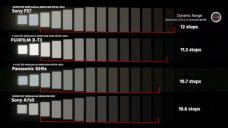
-

 sa10333.jpg800 x 526 - 71K
sa10333.jpg800 x 526 - 71K -
X-T30 first impressions (for video)
4K and FHD resolution quality are great
Shadow/highlight in -1 are great to improve dynamic range. In -2 the image looks washed out / flat.
DR200 and DR400 are great to improve dynamic range, no need log, and it does not hurt shadows or highlights. It just recover highlights 1 or 2 fstops.
DR400 works from iso 640 up to 12800 and can be used togheter with InterFrame Noise Reduction.
Colors are natural and beautiful, no orange in brown objects
Astia is the best film simulation, just set color to -2 when using it. It has better contrast compared to Provia without crush shadows and without flat look. If you prefer Provia set color to +1. No need to use Eterna. Astia and Provia are ok to avoid gradding in post production. If you want a different look use Classic Chrome with color +4.
Low light in 4k is amazing without significant noise up to iso 6400 using Interframe Noise Reduction. InterFrame Noise Reduction only works in 4k, keep it enabled.
In 4k iso 12800 is pretty usable. Iso 25600 is usable if you really need it but noise is visible. Both don't show chroma noise, which is good, and look like a film grain, not like a digital noise. Iso 25600 only enable in DR100 so you cannot recover highlights in iso 25600. (with Interframe Noise Reduction enabled)
Normal Noise Reduction set to -2 helps to minimize noise without introducing mud (in 200mbps).
200mbps is amazing, it works like a GH2 hack, texture, noise and frames cadence are perfect in 200mbps, can rival pro cameras.
Editing 200mbps need to transcode to cineform 422 10bit quality 4 for a smooth playback in timeline. (It worth the effort)
Sharpness -1 deliver good texture and detail without oversharp in FHD and 4k.
1080p60 and 1080p120 upscale good to 4k when slowmotion is needed using GPUResize plugin, but show some amount of aliasing, seems to be a little bit better than G7 and GH2 in terms of aliasing.
Using settings described here can avoid 10bit and can make 8bit looks pretty good without need gradding in post. (sooc, straight out of camera)
Camera is very fragile and feels like a small toy in hands. Very small and less than 400 gramas with battery and sd card.
Sandisk Extreme SDHC U1 C10 32GB 45mbps card works ok for 4k 200mbps.
Maximum weight for lens is 650 gramas. More than this makes the lens mount bend down a little bit, not recomended. Or you need rails / rods to support the heavy lens.
APS-C sensor 23,5 x 13,2 with 1,532x crop factor in horizontal and 1,6x crop factor in diagonal compared to full frame still 36x24mm will deliver the same shallow dof from 35mm Cinema Film.
F2.8 can deliver good shallow dof with APS-C sensor. Even F4 can do it with a telephoto lens. So no need super fast expensive lenses.
Works good with legacy vintage manual focus lenses using the best part of image circle.
It has mic input and audio level can be adjusted, not tested yet.
It has headphones output via usb adapter with volume adjust, not tested yet.
It is possible to adjust aperture, iso, shutter and manual focus assist using dials and buttons, no need to use menu.
OIS kit lens work good for stabilization and has great image at f5.6 from 16 to 50mm.
Same sensor and image processor from the XT3 and XT4, only miss 4K60p and IBIS (main differences). According to cinema5d website this sensor/processor combo deliver 11,2 fstops of dynamic range.
So it is a perfect camera for video with a very competitive price compared to others. It can kill your desires for GH5S M43 and S1 or A7Sii FullFrame.
LCD and Viewfinder resolution is good enough for working.
If you want full frame look you can use a focal reducer, the best cheap one is the "Lens Turbo II" or the Metabones Ultra (expensive).
One bad thing: need to charge battery inside camera with usb charger, need to buy a separate charger.
-
-
How many usable stops you feel you can get out of it? Would recording externally 422 10bit make big difference on this cam?
-
@Vitaliy_Kiselev I am a little bit busy, but maybe I can do some footage later.
@sammy thanks for the question, it made me think about how things work in the real world and how the sensor behaves.
I did an interesting test. I pointed the camera to a fluorescent light bulb in the ceiling and I payed attention to the ceiling surrounding the lamp.
I setted the exposure in a way that the zebras show 100% in the ceiling, so I started to bring exposure down using shutter speed until the ceiling got black.
Using DR400 it was 9 fstops. Using DR200 it was 8 1/2 fstops. Using DR100 it was 8 fstops. So DR400 only improve Dynamic Range 1 fstop
XT30 records video signal between 0 and 100 ire, so there is no way to recover highlights in post.
G7 records video signal between 0 and 110 ire. from 100 ire to 110 ire there are 2/3 fstops (0,67), so if you recover highlights in post bringing 110 ire down to 100 ire, there will be almost 8 2/3 fstops of dynamic range.
So both cameras have almost the same dynamic range, but with Fuji you can get it done in camera, and in G7 you need to do it in post.
In fuji you use the zebra 100% and set the highlight as you want with DR400 enabled. In G7 you use the zebra 100% to find the look you want and then you raise exposure 2/3 fstop (0,67) and then recover in post.
Maybe XT30 can be just 1/3 (0,33) fstop better than G7 in terms of dynamic range, but I am no sure about it.
In both cameras I used shadows/highlight curve. Fuji in -1 / -1 and G7 in -2 / +2 which means the same, because the numbers are different in each other but does the same. Increasing these settings is bad idea because image start to look washed out / flat.
In G7 you can get an extra dynamic range if you enable the iDynamic feature to lift shadows, but I dont like it because increase noise so much.
I dont think F-log will improve anything compared to DR400 in Fuji.
But dont worry about dymanic range with these cameras because both cameras can do a good job showing blue sky and shadows under trees with these settings.
-
Thanks for info, I'm surprised its only around stops ,looks more. The Xt3 I believe is around 11?
-
Hello. XT3 and XT4 have same sensor and same processor of XT30 so dynamic range will be the same. And XT30 also has the Flog, so it is the same.
I think all digital cameras will have the same dynamic range around 9 stops because sensor technology is the same. So sony panasonic fuji nikon canon jvc all will be 9 fstops when using their own dynamic range improvements. Each manufacturer has its own DR improvement. In my opinion Fuji DR improvement is the best.
I dont think log can do any magic... i believe all log cameras will be 9 stops also.
We need another sensor technology to improve this.
You can read about DR improvement in this link:
in cinema5d website they did a test using chart, my test was using the camera shutter speed in a real image, so i believe more in the test i did. I dont believe in 11 stops, i believe in 9.

 fujixdr.jpg640 x 360 - 35K
fujixdr.jpg640 x 360 - 35K -
you saying the S1h has same DR as this and GH5s ?
-
I am saying that I dont believe in dynamic range tests with "charts". I believe in tests with real images. It is much better to trust in a test when you point the camera to a real object and set zebras to 100% in a white point and then start to increase shutter speed to perceive how many fstops you can get until the object got black. This is much better test compared to "charts".
Also before tests the camera can be set to improve dynamic range using its features. In Fuji you can use shadows/highlights in -1 and enable DR400. In panasonic you can use shadows/highlight +2/-2 and recover 110 ire to 100 ire in post. These two cameras shows almost the same dynamic range after tweaking these settings.
I am saying that all sensors in market today have same technology, so I believe that in real world images they will be the same. Maybe recording RAW can improve something, but I never did a try on RAW video. My tests in RAW photo shows that you cannot lift shadows or recover highlights so much because image start to look bad, so I think it is the same for video = 7 fstops from the sensor +1 fstop lifting shadows +1 fstop recover highlights = 9 fstops, same thing when you tweak camera settings and record h264.
I believe to get more dynamic range we need another sensor technology, like quantum film or organic sensor.
Also I finished my research about cameras. I am pretty happy with G7 and XT30. Maybe if I get very RICH someday I can get the S1 due to be full frame, not due to dynamic range, but not now. Or I can wait for a new technology. Period.
-
X-T30 has hiss in external mic audio preamp. It is possible to remove the hiss using audio noise reduction in post production and solve the issue. If you have more money go for the X-T3 because this test below shows no hiss on it:
Edit post.: there are some strange things happening. I tested two mics and one mic have more hiss than the other. The hiss is not just a camera problem. It is also related to the mic. I hope i can find a mic without hiss or with low hiss. There are lots of tests to do before perfect conclusions.
-
Fujifilm X-T30 Mirrorless Camera w/XF 18-55mm f/2.8-4 Lens Charcoal Silver W/ACC for $1199
-
t30 mkII ?
Howdy, Stranger!
It looks like you're new here. If you want to get involved, click one of these buttons!
Categories
- Topics List23,992
- Blog5,725
- General and News1,354
- Hacks and Patches1,153
- ↳ Top Settings33
- ↳ Beginners256
- ↳ Archives402
- ↳ Hacks News and Development56
- Cameras2,367
- ↳ Panasonic995
- ↳ Canon118
- ↳ Sony156
- ↳ Nikon96
- ↳ Pentax and Samsung70
- ↳ Olympus and Fujifilm101
- ↳ Compacts and Camcorders300
- ↳ Smartphones for video97
- ↳ Pro Video Cameras191
- ↳ BlackMagic and other raw cameras116
- Skill1,960
- ↳ Business and distribution66
- ↳ Preparation, scripts and legal38
- ↳ Art149
- ↳ Import, Convert, Exporting291
- ↳ Editors191
- ↳ Effects and stunts115
- ↳ Color grading197
- ↳ Sound and Music280
- ↳ Lighting96
- ↳ Software and storage tips266
- Gear5,420
- ↳ Filters, Adapters, Matte boxes344
- ↳ Lenses1,582
- ↳ Follow focus and gears93
- ↳ Sound499
- ↳ Lighting gear314
- ↳ Camera movement230
- ↳ Gimbals and copters302
- ↳ Rigs and related stuff273
- ↳ Power solutions83
- ↳ Monitors and viewfinders340
- ↳ Tripods and fluid heads139
- ↳ Storage286
- ↳ Computers and studio gear560
- ↳ VR and 3D248
- Showcase1,859
- Marketplace2,834
- Offtopic1,320
Tags in Topic
- fujifilm 40








